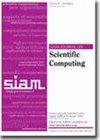利用物理信息神经网络模拟弹性血管中血流的无网格求解器
IF 2.6
2区 数学
Q1 MATHEMATICS, APPLIED
引用次数: 0
摘要
SIAM 科学计算期刊》,第 46 卷第 4 期,第 C479-C507 页,2024 年 8 月。 摘要调查心血管系统中的血流对于评估心血管健康至关重要。计算方法为测量血流动态提供了一些非侵入性的替代方法。基于有限元和其他数值离散等传统方法的数值模拟已得到广泛研究,并取得了卓越成果。然而,将这些方法应用于实际模拟仍是一项复杂的任务。在本文中,我们提出了一种既灵活又能有效处理实际模拟的方法。我们建议利用物理信息神经网络来求解可变形域中的纳维-斯托克斯方程,特别是解决弹性血管中的血流模拟问题。我们的方法使用不可压缩的粘性纳维-斯托克斯方程,以任意拉格朗日-欧拉形式模拟血流。血管壁结构的力学模型是通过牛顿第二动量定律和线性弹性方程来计算流体流动所产生的力。我们的方法是一种无网格方法,无需对计算域进行离散化和网格划分。这使得它在解决涉及复杂几何形状的模拟时非常高效。此外,由于有了完善的开源机器学习框架包和并行模块,我们的方法可以很容易地通过 GPU 计算和并行计算来加速。为了评估我们的方法,我们在普通圆柱形容器和壁上有斑块的容器上进行了实验。我们将我们的结果与使用密集网格和小时间步长的有限元方法计算出的解决方案进行了比较,并将其视为基本真理解决方案。我们报告了相对误差和解决问题所消耗的时间,突出了我们方法的优势。本文章由计算机程序翻译,如有差异,请以英文原文为准。
A Meshless Solver for Blood Flow Simulations in Elastic Vessels Using a Physics-Informed Neural Network
SIAM Journal on Scientific Computing, Volume 46, Issue 4, Page C479-C507, August 2024.
Abstract. Investigating blood flow in the cardiovascular system is crucial for assessing cardiovascular health. Computational approaches offer some noninvasive alternatives to measure blood flow dynamics. Numerical simulations based on traditional methods such as finite-element and other numerical discretizations have been extensively studied and have yielded excellent results. However, adapting these methods to real-life simulations remains a complex task. In this paper, we propose a method that offers flexibility and can efficiently handle real-life simulations. We suggest utilizing the physics-informed neural network to solve the Navier–Stokes equation in a deformable domain, specifically addressing the simulation of blood flow in elastic vessels. Our approach models blood flow using an incompressible, viscous Navier–Stokes equation in an arbitrary Lagrangian–Eulerian form. The mechanical model for the vessel wall structure is formulated by an equation of Newton’s second law of momentum and linear elasticity to the force exerted by the fluid flow. Our method is a mesh-free approach that eliminates the need for discretization and meshing of the computational domain. This makes it highly efficient in solving simulations involving complex geometries. Additionally, with the availability of well-developed open-source machine learning framework packages and parallel modules, our method can easily be accelerated through GPU computing and parallel computing. To evaluate our approach, we conducted experiments on regular cylinder vessels as well as vessels with plaque on their walls. We compared our results to a solution calculated by finite element methods using a dense grid and small time steps, which we considered as the ground truth solution. We report the relative error and the time consumed to solve the problem, highlighting the advantages of our method.
Abstract. Investigating blood flow in the cardiovascular system is crucial for assessing cardiovascular health. Computational approaches offer some noninvasive alternatives to measure blood flow dynamics. Numerical simulations based on traditional methods such as finite-element and other numerical discretizations have been extensively studied and have yielded excellent results. However, adapting these methods to real-life simulations remains a complex task. In this paper, we propose a method that offers flexibility and can efficiently handle real-life simulations. We suggest utilizing the physics-informed neural network to solve the Navier–Stokes equation in a deformable domain, specifically addressing the simulation of blood flow in elastic vessels. Our approach models blood flow using an incompressible, viscous Navier–Stokes equation in an arbitrary Lagrangian–Eulerian form. The mechanical model for the vessel wall structure is formulated by an equation of Newton’s second law of momentum and linear elasticity to the force exerted by the fluid flow. Our method is a mesh-free approach that eliminates the need for discretization and meshing of the computational domain. This makes it highly efficient in solving simulations involving complex geometries. Additionally, with the availability of well-developed open-source machine learning framework packages and parallel modules, our method can easily be accelerated through GPU computing and parallel computing. To evaluate our approach, we conducted experiments on regular cylinder vessels as well as vessels with plaque on their walls. We compared our results to a solution calculated by finite element methods using a dense grid and small time steps, which we considered as the ground truth solution. We report the relative error and the time consumed to solve the problem, highlighting the advantages of our method.
求助全文
通过发布文献求助,成功后即可免费获取论文全文。
去求助
来源期刊
CiteScore
5.50
自引率
3.20%
发文量
209
审稿时长
1 months
期刊介绍:
The purpose of SIAM Journal on Scientific Computing (SISC) is to advance computational methods for solving scientific and engineering problems.
SISC papers are classified into three categories:
1. Methods and Algorithms for Scientific Computing: Papers in this category may include theoretical analysis, provided that the relevance to applications in science and engineering is demonstrated. They should contain meaningful computational results and theoretical results or strong heuristics supporting the performance of new algorithms.
2. Computational Methods in Science and Engineering: Papers in this section will typically describe novel methodologies for solving a specific problem in computational science or engineering. They should contain enough information about the application to orient other computational scientists but should omit details of interest mainly to the applications specialist.
3. Software and High-Performance Computing: Papers in this category should concern the novel design and development of computational methods and high-quality software, parallel algorithms, high-performance computing issues, new architectures, data analysis, or visualization. The primary focus should be on computational methods that have potentially large impact for an important class of scientific or engineering problems.

 求助内容:
求助内容: 应助结果提醒方式:
应助结果提醒方式:


